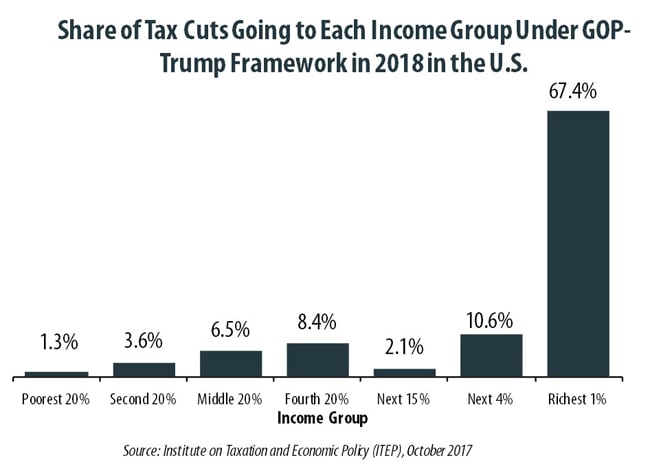The Trump Administration and GOP leaders continue to wrap their multi-trillion tax cut gift to the wealthy in easily refutable rhetoric about boosting the nation’s middle class.
Later today, trucks and truck drivers will serve as a backdrop for a Pennsylvania speech in which Trump is anticipated to talk about how proposed tax changes that solely or primarily benefit the wealthy–such as eliminating the estate tax (which only the richest 0.2 percent of estates pay) and lowering the top tax rate for small businesses–will help working people.
ITEP and other independent analyses of the GOP-Trump tax proposal reveal this rhetoric is false. Frankly, it doesn’t take an analyst to surmise that doing away with the estate tax will singularly benefit the wealthy, but I digress. While owners of large trucking firms may grandly benefit from the GOP tax plan, the men and women who transport goods across the country more than likely fall in income groups that will either see tax cuts that amount to less than 1 percent of their income or face a tax increase.
Overall, ITEP’s 50-state analysis of the GOP-Trump tax framework found that more than two-thirds (67.4 percent) of the proposed tax cut would go to the top 1 percent of taxpayers. Their average tax cut would amount to 4.3 percent of their incomes, while the remaining 99 percent of taxpayers would receive tax cuts averaging less than 1 percent of their incomes.
As GOP leaders double down on duplicitous rhetoric about how the plan benefits the middle class, it’s worth delving deeper into the data for the more complex story. While it is true that some taxpayers in all groups would receive a tax cut, it is also true that nearly one in six taxpayers would pay more as various deductions and exemptions would be eliminated.
Who Trump and the GOP are giving the most and who they are asking to pay more should be a central part of the ongoing tax policy debate. A few findings from ITEP’s analysis:
- Taxpayers in the middle-income quintile who earn from $41,200 to $65,900 are more likely than the richest 1 percent to pay more taxes under the GOP-Trump proposal. While 14.5 percent of this middle-income group would pay more, just 9.1 percent of top earners would do so.
- Nine out of 10 taxpayers in the richest 1 percent would receive a windfall averaging $100,770 per year, a sum that is nearly double the average annual income of the middle 20 percent of taxpayers. Put another way, the Trump-GOP tax framework would give the wealthy an income boost that is two times more than what middle-income households earn in a year.
- Taxpayers with income from $111,000 to $240,900 are most likely to face a tax increase. In fact, 41.6 percent of households in this income group would receive a tax hike.
- Households earning from $111,000 to $240,900 are four and a half times more likely than the richest 1 percent to face a tax hike under the Trump-GOP plan. Their average tax increase ($1,960) would be nearly double that of the less than less than 10 percent of taxpayers in the top 1 percent who would face an average increase of $1,010.

The bottom line is that the Trump-GOP tax framework is a tax plan by the super wealthy for the super wealthy. With its focus on corporate tax cuts, reducing the top individual rate, eliminating the alternative minimum tax and abolishing the estate tax, this plan is not intended to benefit the middle class—no matter the rhetoric coming from lawmakers and anti-tax special interests, and no matter how many symbols of hardworking men and women such as trucks are used at rallies and other public events.
As ITEP executive director Alan Essig recently said, “The plan boosts the incomes of the wealthy with surgical precision, but gives a pittance to most working people. And it would tax some in the middle and upper-middle class more, essentially creating an even greater economic divide between the rich and everyone else.”
The federal government continues to run annual budget deficits and underinvest in areas such as infrastructure (which is necessary to keep roads safe for truck drivers), health, and the social safety net. Most economists agree that tax cuts will not pay for themselves or super charge economic growth, as Republican leaders and supply-side adherents continue to claim.
So, having a national public policy debate about whether the federal government needs to increase taxes on income groups beyond the top 1 percent so that it can meet its basic priorities is a legitimate policy question. But, to be sure, this framework is not focused on raising revenue so the nation can fund its basic priorities. Instead, it would finance tax cuts for the top 1 percent by increasing taxes on a significant percentage of middle- and upper-middle class taxpayers, and by decimating the federal budget and forcing cuts to programs that benefit vulnerable populations.
If there were a textbook way of making income inequality worse, the Trump-GOP tax framework would be it. Congress should scrap this plan.





